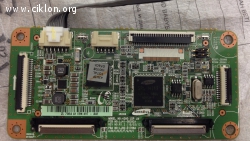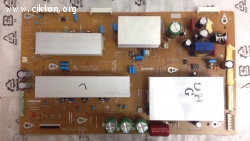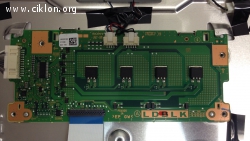Databook - 5000 Integrated Circuits - power audio amplifiers
Edition 2008
INTRODUCTION
One of the basic components of any sound-reproducing system, without dependence from its class is the power
amplifier of audio frequencies called also the power audio amplifier.
With reference to consumer and professional electronics equipments, the greatest popularity are the integrated
circuits-power audio amplifiers, due to their advantages - schematic simplicity, small dimensionss, large range of
output powers, polyfunctionality.
For correct usage of integrated circuits of the power audio amplifiers, irresepective of a field of application, it is
necessary to know following:
- Function of integrated circuit;
- The main electrical characteristics;
- Schematic of connection and (or) internal structure;
- Package type;
- Equivalents (replacements).
In the literature, the great many of the characteristics which one describe the electrical and operational param-
eters of power audio amplifiers depending on evaluation yardsticks and can give completely different estimations to
quality of operation of a amplifiers. Main of parameters used for the description of power audio amplifiers is following:
a gain; a bandwidt; a dynamic (phase, phase-frequency, peak (amplitude)) characteristic; linear and nonlinear
distortions; efficiency; input characteristics (impedance, current, voltage and power, impedance of a source of an
input sound signal); output characteristics (impedance, current, voltage, output power); a dinamic range; signal-
to-noise ratio and maximum ratings of electrical parameters.
The gain Gv (on a current, a voltage or power, depending on purpose of the amplifier) represents the logarithm
of the ratio of signal output from a amplifier to signal input to the amplifier. The gain Gv can be expressed as a direct
ratio (V/mV or V/µV), and in the logarithmic relation (in decibels -dB). The gain depends on value of external compo-
nents, from resistance of loading Rl, input resistance Rin, a supply voltage Vcc, frequency and temperature.
The frequency bandwidt Bw - area of frequencies (a bandwidt from bottom limit frequency Fl up to top fre-
quency Fh) within the gain changes no more than on ±3 dB, concerning gain measured on frequency 1 KHz. In the
certain cases when the manufacturer wants to emphasize the expanded range of working frequencies of the amplifier
at the improved non-uniformity frequency characteristics, the size of non-uniformity (1 dB, 0,5 dB etc.) is indicated
also.
Instead of a frequency bandwidt, sometimes defined a frequency bandwidt at gain equal to unit or a power
frequency bandwidt. The frequency bandwidt at gain equal to unit is an interval of frequencies on which borders the
gain values equal to unit. The power frequency bandwidt is an interval of frequencies within the limits of which at the
certain factor of distortions k, output power changes no more, than on ±3 dB in relation to output power on frequency
in 1 KHz.
The dinamic range determines a ratio between maximum output and input tension of the amplifier. The ratio
usually expresses in decibels and represents (in a theoretical case) a linear function.
The frequency characteristics determines relation of a gain of amplifier to frequency; phase characteristics -
the phase shift of an output signal on relation to input signal (in frequency function of an input signal).
The frequency - phase characteristic summarizes frequency and phase characteristics of the amplifier in the
field of a range of reproduced frequencies.
All amplifiers alter input signals, generally in two ways: they make them stronger (amplify) them, and they add
characteristics which did not exist in the original signal. These undesirable characteristics are lumped together and
called distortion. Noise can be considered a type of distortion.
One common type of distortion is harmonic distortion. Harmonics of a signal are signals which are related to
the original (or fundamental) by an integer (non decimal) number. A pure tone (sinewave) signal has no harmonics; it
consists of only one single frequency. If pure tone signal was applied to the input of an amplifier, we would (upon
measurement with special test equipment) find that the output signal of the amplifier was no longer pure. Careful
measurements would likely show that several new frequencies have appeared. These new frequencies are almost
certainly to be integer multiples of the original tone; they are the harmonics of the original signal. In a good amplifier,
the harmonics will be much weaker than the original tone. By much weaker, we mean on the order of a thousand times
for decent amplifiers.
Intermodulation distortion is the second major type of distortion that is often specified for amplifiers.
Intermodulation distortion is much more objectionable to the human ear, because it generates non-harmonically
related extra signals which were not present in the original. Basically, two pure tones are simultaneously applied to
the input of the amplifier. If the amplifier were perfect, the two tones (and only the two tones) would be present at the
amplifier output. In the real world, the amplifier would have some harmonic distortion (as described above), but careful
observation of the output signal (using laboratory equipment) would reveal that there are a number of new tones
present which cannot be accounted for as a result of harmonic distortion. These new tones are called beat prod-
ucts or sum and difference frequencies, and are a result of the interaction of the two pure tones within the amplifier.
No amplifier is perfect, all have some non linear characteristics. Whenever two signals are applied to a nonlinear
system, new signals (in addition to the original two) are generated. For a good amplifier, the new signals are very small
in relation to the two original tones.
All amplifiers are generally rated for Total Harmonic Distortion (or THD), usually at full power output over a
given frequency band with a particular load. Good values are anything less than 0.5 %THD. When an amplifier is
measured for THD, a pure tone is applied to the input and the output is measured with special test equipment. The
energy of the pure tone is measured, and the energy of the harmonics is measured. Those two values are compared,
and a THD rating is calculated. A THD rating of 1% means that the total energy of all the harmonics combined is one
one-hundredth of the energy in the fundamental. Harmonic distortion (although certainly undesirable) is one of the
more tolerable types of distortion as long as it is kept reasonably low. Distortion levels of 10% may be very tolerable.
4
At increase of input signal Uin the output voltage, a current and power are increased, but also the factor of
nonlinear distortions simultaneously grows. Therefore, for reduction of nonlinear distortions target capacity of the
amplifier are artificial limit in comparison with the greatest possible output power.
As sensitivity of the amplifier understand value of the sine wave input voltage, necessary for obtain of the
maximal output power. Frequently, some manufacturers indicates value of a nominal input voltage. A nominal input
voltage is a sine wave voltage applied to an input of the amplifier for obtain of nominal output power. It is meant, that
the volume regulator of the amplifier should be exposed on the maximal value.
Besides linear and nonlinear distortions, any real amplifier generate the additional signals. Because of it, on an
output of the amplifier there is a signal distinct from zero, even in absence of an entrance signal. This signal called as
output noise and can be considered as the sum of infinite number of sine wave voltage (not only harmonious) includ-
ing in a sound range of frequencies. Sources of internal noise of the amplifier are thermal noise of resistors, and also
shot, flickering and thermal noise of active components (transistors and diodes). Quantitatively a value of noise on an
output describe through effective value of noise Uno. As the voltage of noise grows simultaneously with a range of
reproduced frequencies, it is necessary to specify frequencies within the limits of which measurements of noise on an
output of the amplifier were made. If the range of frequencies is not underlined, own noise are measured within the
limits of a working range of frequencies of the amplifier.
The range of change of a output voltage is determined by a difference between the maximal and minimal instant
value of a voltage on an output of the amplifier. This parameter called sometimes a peak output voltage and desig-
nate Up-p (peak-to-peak).
There are many terms used to describe the amplifier power ratings- the maximal sinusoidal power, maximal
continuous power, RMS power, music power (IHFM), peak power, instantaneous power. Depending on indicated term
for output power, the same amplifier can have value which one differ in some times. Not resorting to the theories we
shall mark that:
Maximal sinusoidal power- is the power delivered on optimal load (for the given amplifier), at a sine-wave input
signal, when THD of the output signal reaches value of 10%.
Maximal continuous power- this same as maximal sinusoidal power and occurs under such name in the
datasheets of USA and Japan manufacturers.
RMS power- (Root Mean Square power). In the simplified form is described as the power, giving on optimal load
(for the given amplifier), at a sine-wave input signal, when output signal completely limits by an output stage of the
amplifier and gains the square shape.
Musical power- IHFM (Institute of High Fidelity Manufactures) is the power delivered on optimal load (for the
given amplifier), at a complex (musical) input signal, when THD of the output signal reaches value of 10%.
The peak power and instantaneous power describe extreme (critical) operation conditions of the amplifier and
are specified basically in the advertising purposes.
The impedance of load Rl has optimal value for each amplifier and determines a maximum output current
(power) giving by the amplifier. If the impedance of load is less than a optimal value, a output current (accordingly
output power) of the amplifier can exceed maximum rating and he can be shattered. If the impedance of load is more
than optimal value, the output current (accordingly output power) of the amplifier will be less (under identical condi-
tions of operation) than is specified for the given amplifier.
On a connection type of load it is possible to distinguish single ended (SE) and Bridged-Tied Loads (BTL)
amplifiers. On a single ended amplifiers the load are connected between an amplifier output and ground (GND).
Bridged amplifiers work basically as follows: a single input signal is applied to the amplifier. Internal to the amp, the
input signal is split into two signals. One is identical to the original, and the second is inverted (sometimes called
phase-flipped). The original signal is sent to one channel of the amp, and the inverted signal is applied to the second
channel. Amplification of these two signals occurs just like for any other signal. The output results in two channels
which are identical except one channel is the inverse of the other. The load is connected between the two amplifier
output terminals. In words, one channel pulls one way while the second channel pulls in the opposite direction. This
allows to delivered (at same load and at same power supply) in 3 times lot of power than at single ended amplifiers.
Due to improvements in the speed, power capacity and efficiency of modern semiconductor devices, the class-
D amplifiers recently have received broad applying. Class-D amplifiers use a technique called pulse width modulation
(sometimes combined with pulse frequency modulation). The input signal is converted to a sequence of pulses whose
width at any time is proportional to the amplitude of the signal at that time. The frequency of the pulses is typically
thirty or more times the highest frequency of interest in the input signal. The main advantages of a class- D amplifiers
are efficiency and simplicity. Efficiencies are in the 80% to 90% range. Because the output pulses have a fixed
amplitude, the switching elements (usually MOSFETs) are switched either on or off, rather than operated in linear
mode. This means that very little power is dissipated by the transistors except during the very short interval between
the on and off states. The wasted power is low because the instantaneous power dissipated in the transistor is the
product of voltage and current, and one or the other is almost always close to zero.
This book proposes the short but full prezentation of the majority (about 5000) integrated circuits - power audio
amplifiers that exist on the market; prezentation consisting from schematic diagrams (schematic of connections and
(or) internal structure), short specification and basic electrical characteristics.
The schematic diagrams of integrated circuits with the identical terminal configurations (and connection) are
arranged in the same place. They are not specifically equivalent (replacements) with each other (can have to different
electrical characteristics and (or) type of case); for detection of equivalent, in any situation it is necessary to consult a
electrical characteristics.
Подкрепете този сайт (CiklonElectro)
Категории
Препоръчани файлове
Обяви
-
Телевизори / LCD телевизори
13.03.2025 г.Платката е работеща, от ТВ с дефектен дисплей.
-
Плазмени телевизори / Logic Boards
13.03.2025 г.Работещи платки от уред със счупен панел
-
Плазмени телевизори / Y-SUS платки
11.04.2025 г.Платки от плазмен телевизор със счупен дисплей.
-
Телевизори / LCD телевизори
13.03.2025 г.Платката е работеща, от ТВ с дефектен дисплей.
-
Телевизори / LCD телевизори
13.03.2025 г.Платката е от ТВ със счупен дисплей.
-
Плазмени телевизори / X-SUS платки
11.04.2025 г.Платки от плазмен телевизор със счупен дисплей.
-
Телевизори / Плазмени телевизори
11.04.2025 г.Платката е тествана,от TV със счупен дисплей 42T30010
-
Плазмени телевизори / Logic Boards
11.04.2025 г.Платки от плазмен телевизор със счупен дисплей.
-
Плазмени телевизори / Logic Boards
11.04.2025 г.Платки от плазмен телевизор със счупен дисплей.
-
Телевизори / LCD телевизори
13.03.2025 г.Платката е от ТВ със счупен дисплей.
-
Телевизори / LCD телевизори
13.03.2025 г.Платката е от ТВ със счупен дисплей.
-
Плазмени телевизори / Logic Boards
11.04.2025 г.Платката е тествана,от TV със счупен дисплей 42T30010
-
Плазмени телевизори / X-SUS платки
13.03.2025 г.Работещи платки от уред със счупен панел
-
Телевизори / LCD телевизори
13.03.2025 г.Платката е от ТВ със счупен дисплей.
-
Телевизори / Плазмени телевизори
13.03.2025 г.Платката е тествана,от TV със счупен дисплей 42T30010
















